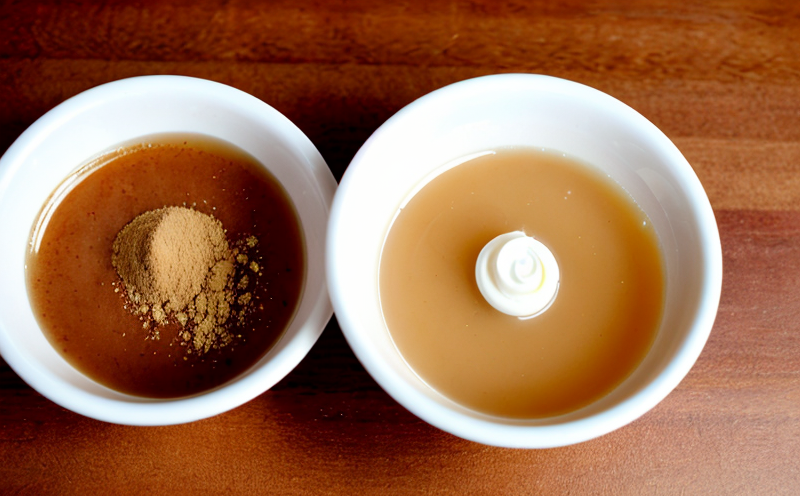GB T 15687 Flavor Additive TBHQ Testing
The GB/T 15687-1995 standard specifies methods for the determination of tert-butylhydroquinone (TBHQ) in flavor additives. This testing is crucial to ensure that the quality and safety standards are met, especially in food products where flavors play a significant role in consumer satisfaction.
TBHQ is widely used as an antioxidant in various industries, including food, pharmaceuticals, and cosmetics. In the context of flavor additives, it helps prevent oxidation, thereby extending product shelf life and maintaining product quality. However, its presence must be controlled to avoid any adverse effects on human health. This test ensures that TBHQ levels are within permissible limits as defined by regulatory bodies.
The testing process involves several critical steps to ensure accurate results. Specimen preparation is the first step where samples from flavor additives are extracted and purified using appropriate techniques such as liquid-liquid extraction or solid-phase extraction. The purity of the specimen directly impacts the accuracy of the test, emphasizing the need for precise handling.
The next step involves instrumental analysis using gas chromatography (GC). GC is chosen due to its high sensitivity and selectivity in detecting TBHQ. Chromatographic conditions are optimized based on standard operating procedures provided by GB/T 15687-1995. The identification of TBHQ is achieved through comparison with a known standard, ensuring that the results are reliable.
After chromatography, quantification is performed using peak areas or peak heights. Calibration curves are established using known concentrations of TBHQ to relate instrument responses directly to the concentration of TBHQ in the sample. This step ensures precision and accuracy in determining the amount of TBHQ present in flavor additives.
The final report includes detailed information on the testing process, including specimen preparation, instrumental conditions, calibration data, and results. Compliance with GB/T 15687-1995 is paramount to ensure that all quality standards are met. This comprehensive approach guarantees that TBHQ levels in flavor additives meet regulatory requirements.
Understanding the importance of this test can help stakeholders, including quality managers, compliance officers, R&D engineers, and procurement teams, make informed decisions regarding product development and supply chain management. By adhering to these standards, organizations ensure not only regulatory compliance but also consumer safety and satisfaction.
- Customer Impact: Ensures that products are safe for consumption, thereby enhancing customer trust and loyalty.
- Supply Chain Efficiency: Minimizes the risk of non-compliance issues, reducing costly recalls and reputational damage.
- Innovation Support: Provides reliable data to support ongoing research and development efforts in food science.
Why It Matters
The importance of GB/T 15687-1995 testing cannot be overstated. Compliance with this standard is essential for several reasons:
- Regulatory Requirements: Many countries have set maximum allowable limits for TBHQ in various products, including flavor additives.
- Safety Concerns: Excessive levels of TBHQ can lead to health issues. Ensuring compliance helps protect consumers from potential risks.
- Market Access: Meeting these standards facilitates market access and ensures that products are acceptable in international markets.
In the context of flavor additives, adherence to this standard is particularly critical because flavors not only enhance taste but also play a role in brand identity. A bad batch or improperly tested additive can lead to significant financial losses due to product recalls or market withdrawal.
For organizations involved in food production and development, ensuring that their products meet these standards is vital for maintaining quality, consistency, and safety. By adhering to the testing procedures outlined in GB/T 15687-1995, companies can build a reputation for reliability and trustworthiness.
The broader implications extend beyond individual organizations to encompass public health and consumer protection. Ensuring that TBHQ levels are within safe limits contributes to overall public well-being and supports the ethical responsibility of food manufacturers.
Customer Impact and Satisfaction
- Informed Decision-Making: Customers can rely on the results of this testing, knowing that their products meet strict quality standards.
- Better Product Quality: By ensuring TBHQ levels are within acceptable limits, customers receive products with consistent flavor and quality.
- Increased Consumer Trust: Compliance with international standards fosters trust in the brand and product integrity.
- Enhanced Brand Image: Meeting these rigorous testing standards can elevate a company's reputation and market position.
- Cost Efficiency: Preventing non-compliance issues saves on potential recall costs and reputational damage.
- Innovation Support: Reliable test results help in continuous improvement and innovation within the product development cycle.
The impact of this testing extends to both direct and indirect stakeholders. For customers, it means safer products that are free from harmful additives. For suppliers and manufacturers, it ensures compliance with international standards, thereby opening up new markets and opportunities for growth. Ultimately, this testing contributes to a more transparent and trustworthy food industry ecosystem.
International Acceptance and Recognition
The GB/T 15687-1995 standard is internationally recognized for its rigorous approach to TBHQ testing in flavor additives. This recognition stems from the standard's alignment with broader international standards such as ISO, ASTM, EN, and IEC.
Many countries have adopted or reference this standard in their own regulations and guidelines. For instance, the European Union (EU) and the United States Food and Drug Administration (FDA) both use similar principles to ensure food safety. By adhering to GB/T 15687-1995, organizations demonstrate a commitment to global best practices.
The acceptance of this standard also extends to regulatory bodies worldwide. Compliance with these standards is often a prerequisite for market access in various countries, including China, the United States, and European Union member states. This recognition ensures that products meet not just domestic but international safety and quality benchmarks.
The widespread adoption of GB/T 15687-1995 highlights its importance in maintaining consistent product quality across borders. By following this standard, organizations can ensure their products are acceptable and competitive in the global market. This recognition also underscores the value of rigorous testing procedures in maintaining consumer trust and satisfaction.





